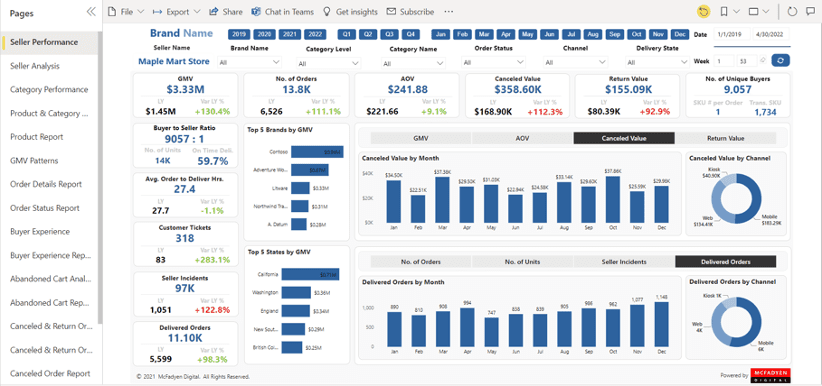
In a typical marketplace, having sellers deeply engaged can make the difference between a profitable and unprofitable platform. But seller engagement is not easy—they often have their own systems, and are selling through multiple channels, meaning that they may or may not have a view of performance on your site that aligns to your data. It is a chicken and egg effect—sellers need the insight to be actionable on your site, but the organization of the seller data often falls to difficult tools—spreadsheets and isolated databases. The democratization of this data – putting it in the hands of the sellers to whom it matters most – is vitally important.
With the new release of the new Marketplace Performance Management Dashboard v1.2, multi-vendor commerce operators will have substantial new capability in recruiting and managing their seller community. Until this release, the MPM dashboard was focused on operator operational and strategic reporting and analytics, giving timely insights into the performance of their marketplace and showing areas in their business needing enhancement or correction. Seller performance was measured, but the dashboards and reports were views across the seller population—not data easily shared with the individual seller.
With this release, operators can extend the capabilities they leverage to manage their marketplace in the core MPM offering to their seller community. This means substantial benefit to the operators as well as the sellers. Operators no longer need to send their seller community reports and XLS files that may or may not get reviewed, and may or may not be understood. With the new MPM 1.2 Seller Dashboard & Reporting functions, each seller gets their view of performance in clear and concise dashboards and reports—with no chance of disagreement on how data is arrived at or calculated. Security is maintained so that each seller sees only their own data.

Sellers can see their individual GMV, AOV and profitability, as well as category and product line results. Further, sellers get immediate insight into problem areas like delayed and incomplete shipment, promotion impact and, where data is available, customer satisfaction inputs. For the first time, operators and sellers can work from the same data, and determine how to maximize individual seller performance on the marketplace.
While Seller dashboard is just another feature in the MPM product, it will dramatically impact the relationship between operators and sellers since focus can now be exclusively on improving each seller’s individual performance on the site. Operators do not need to review basic information with sellers, since both the operator and the seller are looking at the same information. This allows both operators and sellers to quickly turn to strategic opportunities for improvement on the site. This is the ultimate win for all parties—consistent data in easy to comprehend format with easy to see (and action) trends and patterns in the data.
With these new dashboards, sellers and operators get insights into the data both collectively and specific to a seller. Operators can easily see how sellers are performing compared to all other sellers, or other sellers in that brand or category. Operators can also see how sellers are performing across time and geography—including delivery timing, and customer satisfaction. The same view is available to the seller, restricted to their individual data. If a seller is having a challenge in a category, geography, or other dimension, all parties can work off the same insights to come to a best possible solution.
Lets take a specific example: ‘Acme Supply’ is a seller on the ‘Sublime’ marketplace. Acme has had success on the marketplace, but in the category of shovels, Acme has the lowest GMV. This has actually impacted other business on the Sublime site. As Sublime and Acme look at what’s going on, they see a pattern that shovels do well in the beginning of the quarter but not as well later in the quarter. As they look closer, they can see that there are replenishment problems and customers are more likely to encounter a stock out condition. This not only impacts Acme’s business, but also causes problems for the Sublime site, as attempts to order shovels and other items late in the quarter result in abandoned carts when buyers cant get their primary product. Acme works to reduce late quarter stock outs, and both Sublime and Acme see an improvement in late quarter business.
Would this have been apparent without the MPM dashboards and reports? Maybe, but MPM gave the timing and insight much faster and in context—for both the operator and the seller. The value is in the speed with which to respond to situations like the above.
How you will use the new Seller Dashboard capability in MPM is hard to say, but with well over 100 KPIs across the MPM offering it is safe to say that the many best practice measurements in the MPM tool set will help your business—and there is a very good chance that the best practice metrics in MPM will improve the performance of your site and the performance of your sellers on you site!
To schedule a demo of the Marketplace Performance Management Dashboard ad to learn more about the importance of seller data, please email us at info@mcfadyen.com.
AUTHOR
Robert Werkema, VP of Product Marketing
McFadyen Digital
Related Articles
Turn Insight Into Impact.
Start Today.




